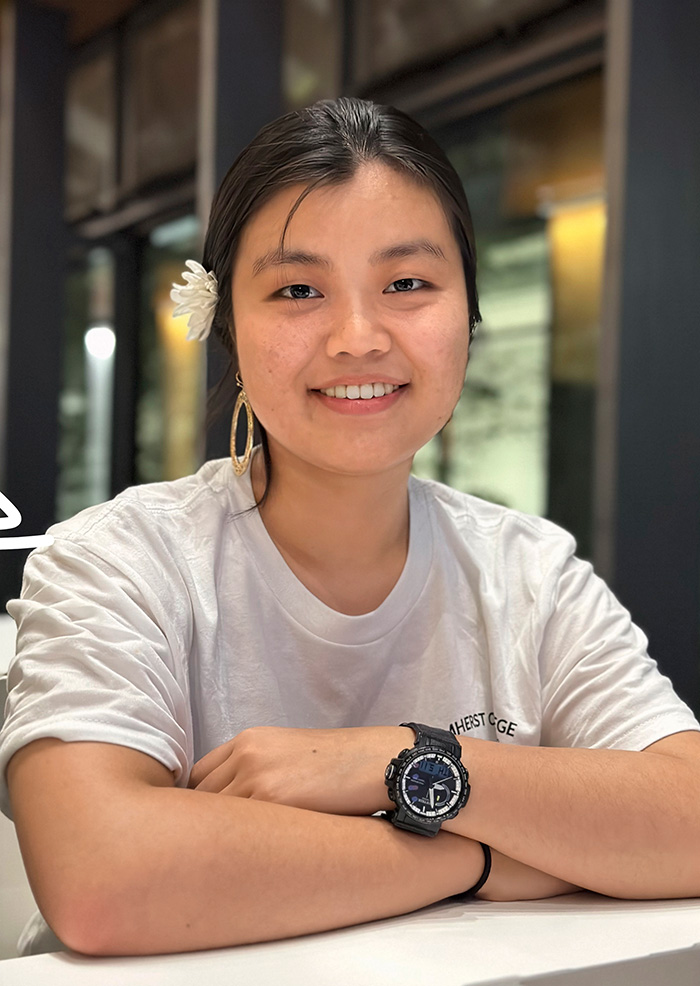
Yasuno met with people who live near uranium mining sites, including Norman M. Begay, a Navajo Nation Council delegate.

Imari Yasuno ’24 wants to understand our nuclear history—and our nuclear future.
Imari Yasuno ’24—Amherst College’s latest winner of a $10,000 Projects for Peace grant—grew up in Nagasaki, Japan, amid enduring echoes of a nuclear explosion. As a high school student in 2015, she attended a 70th-anniversary commemoration of the city’s devastation by a U.S. atomic bomb during World War II. There she heard the testimony of a hibakusha (atomic bomb survivor) named Sakue Shimohira.
“Her story was very emotional and painful,” Yasuno remembers. Shimohira described losing her sister to suicide in the wake of the attack, and she impressed upon the audience a key element of promoting peace: trying to understand the pain of others. “And ever since,” Yasuno says, “she really inspired me to work on this issue and contribute to peacebuilding and try to have more opportunities to listen to people’s stories.”
While still in high school, Yasuno joined a volunteer organization that traveled all over Japan, giving lectures and collecting signatures on petitions for nuclear disarmament. She even gave a speech at the United Nations in Geneva. As a student at Doshisha University, where she earned a degree in social work, she developed an exchange program to teach more than 100 teenagers from Nagasaki, Hiroshima and Hawaii about nuclear issues; the program garnered attention on Japanese national television. She also wrote a thesis paper on the everyday life experiences of hibakusha.
Yasuno arrived at Amherst last year and is working toward a second bachelor’s degree, in anthropology, while continuing her activism through her Project for Peace. “While mainstream discourse tends to showcase only the moment of explosion in Hiroshima,” she wrote in her application for the grant, “my project focuses on the ongoing physical and emotional pain, loss, and people’s constant fight with illness and trauma: a true representation of war.”
That trauma, she emphasizes, reverberates across communities and down through generations: Hibaku-nisei (children of atomic bomb survivors) “have been neglected by all compensation acts ever since they were born, both in the United States and Japan. Although their experiences are quite different from the first generations and atomic bomb survivors, they faced similar issues, like high cancer rates and social and internal stigmatization.”
Last summer, Yasuno used the Projects for Peace funding to return to Japan to interview 10 hibaku-nisei. Some of these people, she found, were committed to advocacy for survivors’ rights and disarmament, while others had chosen not to be actively involved. “The commonality they had is they didn’t really hear experiences of their parents when they were younger,” she says, “and they were also hesitant to ask, because they knew that it was such a traumatic experience.”
The summer project then took Yasuno to New Mexico, Colorado and Utah to visit Los Alamos National Laboratory and to speak with Americans affected by U.S. nuclear activity, including those living on Navajo land contaminated by uranium mining and those residing downwind of nuclear testing sites.
The project also involved educating young people about her findings: “I was able to talk to students in Nagasaki—some of them are from my high school,” Yasuno says. “They were really fascinated to know about people affected by atomic bombs that are not in Nagasaki but all over the world.”
This fall semester, Yasuno worked with Professor of Anthropology Christopher Dole in a special topics course they titled “Radiation Studies,” which traces nuclear issues from mining of materials, to weapon building, to weapon testing, to international war, to production of electrical power, with a focus on the human beings who are “entangled with those big cycles of systems,” she says. She appreciates the opportunities she’s had at Amherst to synthesize many different perspectives into her work and to talk with faculty and fellow students about her longtime passion.
In fact, the next steps of her Project for Peace, Yasuno hopes, will be to distill the narratives she gathered from the interviews into written materials that can be distributed through the United Nations’ disarmament education initiative. That way, she says, “I can share the stories to other people, much larger circles.”
Photos: Courtesy of Imari Yasuno ’24 and Giles Clarke